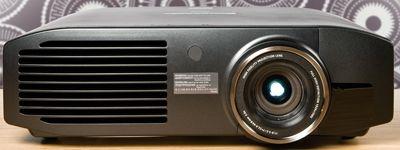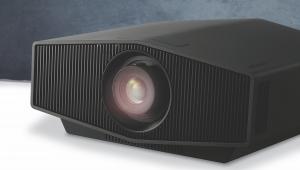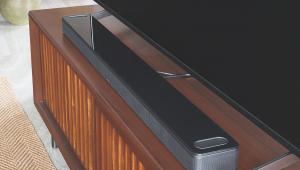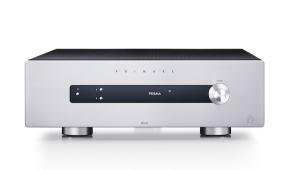Panasonic PT-AT5000 review

From the moment I first saw Panasonic’s new PT-AT5000 3D projector running alongside its AE4000 predecessor at a swanky launch event in Los Angeles, I knew it was going to be something special. Though not necessarily because of its headlining 3D talents.
For during this demo it seemed that the technological advances demanded to deliver convincing 3D pictures (see page 54) had led to Panasonic delivering a quantum leap in its 2D performance, too. And this first impression still holds true now that I’ve managed to get the machine ensconced in my own test room.
Thankfully, the AT5000 isn’t as dog ugly as its bizarrely industrial-looking AE4000 predecessor. And while it is unlikely to wind up at any ‘industrial design’ award ceremonies, it’s slimmer, more attractively finished and more curvaceous than the brick-like older sibling, allowing it to integrate much less discordantly with your home’s decor.
Trigger happyThe AT5000 is extremely well connected by projector standards, thanks predominantly to its provision of a pair of 12V trigger outputs and three HDMIs, where most projectors (even many costing five figures) only manage two. These HDMIs are all built to the 3D-friendly v1.4 spec.
Turning to the AT5000’s front, a little flap-covered compartment to the right of the lens contains two items of interest: a built-in 3D transmitter and an unusual joystick-style system for optically shifting the picture horizontally or vertically. The transmitter worked adequately well during my tests, though if you’ve got a large room or lots of pairs of glasses to ‘feed’, you might well need to stump up for one of Panasonic’s optional extra external transmitters.
The joystick image shifter certainly did not work adequately well during my tests. It’s horribly insensitive and refuses to move until you apply lots of pressure, but then it suddenly shifts extensively, making small adjustments hard to achieve. It’s bizarrely imprecise for a projector that offers so much subtle fine tuning in so many other areas.
For instance, the AT5000 offers a really extensive range of adjustments for tweaking colours, contrast, white balance and gamma levels, along with some unusually sophisticated displays for monitoring the results of your labour. The WaveForm monitor, in particular, is something that’s only normally seen in a lab rather than being available for end users to study, depending on your level of technical knowledge.
Actually, quite a few of the AT5000’s set-up tools will likely be beyond the comfort zone of most of the people who buy one. So it’s reassuring to discover that the picture presets – at least the Cinema ones – are pretty good, meaning you don’t necessarily have to muck about with the finer points of calibration at all if you don’t fancy it.
One last feature of the AT5000 that should be mentioned before checking out its headlined new 3D talents is its lens memory function. This neat trick can store different zoom and focus settings for different film aspect ratios, so you don’t have to manually configure the settings yourself each time you want to switch between, say, a 2.35:1 and a 1.85:1 ratio film. If this feature interests you, though, you should be aware that it doesn’t work for 3D, though.
With Panasonic’s pre-launch claims that it didn’t want to release a 3D projector until it was happy with its quality ringing in my ears, I fired up Tangled and Avatar on 3D Blu-ray. And for the most part, I was more than happy with what I saw.
Colour calibrationFor a start, the AT5000’s 3D images look chock full of HD detail, easily delivering the resolutions the active 3D format was expressly designed to handle. The projector’s 3D picture settings also benefit from some obvious care on Panasonic’s part when it comes to calibrating the AT5000’s colour settings to compensate for the impact of the brand’s 3D glasses. Colours in both animated and filmed 3D scenes look strikingly natural, as well as enjoying more blend and tonal shift subtleties than usual.
Motion looks fluid but believable in 3D mode too, be it motion across the frame or in and out of the depth of field. Talking of depth, there’s always a really palpable sense of ‘3Dness’ to the AT5000’s 3D pictures, avoiding the slight lack of depth seen with some 3D displays. The image’s sharpness helps underline the sense of depth too, as the crispness with which different objects are rendered helps your eyes correctly define their relative positions in the 3D field.
The AT5000’s 3D images are respectably bright and vibrant compared with those of other similarly priced 3D projectors. What’s more, the AT5000 runs surprisingly quietly even when it’s having its lamp worked hard by 3D playback, revealing how efficient Panasonic has been with the AT5000‘s heat management.
Many of the 3D-related innovations Panasonic has introduced for the AT5000 have been concerned with suppressing that trademark active 3D problem of crosstalk noise. So it’s a touch disappointing to find that there is still some evidence of the double ghosting noise over ‘classic’ scenes such as the lantern sequence in Tangled and Avatar’s early classroom scene. It’s fairly subtle, though, and doesn’t prevent the 3D image’s sharpness from being the defining part of your viewing experience.
On the other hand…Now, having just said that the AT5000‘s 3D brightness is quite good, I’m now going to confuse the heck out of you by saying that it’s also a bit disappointing.
The thing is, while the AT5000’s 3D pictures look bright enough compared with other 3D projectors, they look positively muted when compared with the phenomenal 2D pictures it produces. I for one had been quite impressed with the ‘punch’ of the AE4000’s images when that model came out in early 2010. But the AT5000 looks like a qualitative leap rather than evolutionary step on from its predecessor, so intense are its colour saturations, so bright are its peak whites and so expansive is its contrast range.
It’s not just the new brightness and colour punch that explains the obvious contrast boost either. For the AT5000 also delivers hugely improved black levels. Indeed, the depth of blackness it can render without crushing out shadow detail are the best I’ve seen from any LCD projector, even outgunning the efforts of Epson’s superb TW5500.
There were moments where I actually felt as if the AT5000’s 2D pictures were too good. Why? Because I was so taken with their brightness and dynamism that I found myself sometimes reluctant to sacrifice either of these attributes to the extent required by the projector’s 3D mode.
Whatever ‘philosophical’ debates the AT5000 might unwittingly raise about the attractiveness of 3D viewing versus the attractiveness of high-quality 2D viewing, though, it’s a simple reality of home cinema life that even the most die-hard of 3D fans will still spend the majority of their time watching 2D, simply because there are so many more 2D sources. So the benefits reaped by 2D from Panasonic’s 3D-related improvements are most definitely a cause for serious, air-punching celebration rather than any sort of misplaced concern. Grab a demo of this PJ now – you’ll be impressed.
HCC VERDICT
Panasonic PT-AT5000
Price: £3,200 Approx
Highs: Good 3D pictures; quiet running; loads of set-up features
Lows: Some crosstalk; fiddly optical image shift system; big drop off in brightness moving to 3D
Performance: 5/5
Design: 3/5
Features: 5/5
Overall: 5/5
Specifications
3D Ready: yes, Active Shutter
Full HD: yes 1080p24
Component video: yes 1
HDMI: yes 3 (v1.4)
PC input: yes (D-Sub)
12V trigger: yes 2
Resolution: 1920 x 1080
Brightness (claimed): 2000 Lumens
Contrast ratio (claimed): 300,000:1 dynamic
Dimensions (max): 470(w) x137(h) x 345(d)mm
Weight: 8.7kg
Features: 3D parallax and colour balance adjustment; extensive colour/white balance/contrast/gamma calibration aids; Waveform monitor; vertical and horizontal image shift; 3D transmitter built in; 200W red-rich lamp; 480Hz panel drive; intelligent lens memory; 22dB fan noise; 4,000 hour lamp life
 |
Home Cinema Choice #351 is on sale now, featuring: Samsung S95D flagship OLED TV; Ascendo loudspeakers; Pioneer VSA-LX805 AV receiver; UST projector roundup; 2024’s summer movies; Conan 4K; and more
|






















































